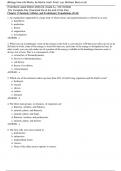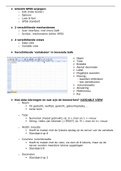Chapter 1 Chemical, Cellular, and Evolutionary Foundations of Life Copyright Macmillan Learning. Powered by Cognero. Page 1 1. An explanation supported by a large body of observations and experimentation is referred to as a(n): a. hypothesis. b. prediction. c. theory. d. supposition. e. investigation. ANSWER: c 2. When you eat a hamburger, some of the energy in the food is converted to ATP that your cells can use to do all kinds of work, some of the energy is stored for later use, and some of the energy is dissipated as heat. In other words, you can only make use of a portion of the energy available in the hamburger because some is always lost as heat. This is a consequence of the: a. second law of thermodynamics. b. first law of thermodynamics. c. cell theory. d. theory of evolution. e. central dogma. ANSWER: a 3. Which one of the elements makes up more than 40% of both living organisms and the Earth's crust? a. hydrogen b. oxygen c. silicon d. carbon e. nitrogen ANSWER: b 4. The three main groups, or domains, of organisms are: a. Bacteria, Archaea, and Eukarya. b. animals, plants, and Bacteria. c. animals, plants, and fungi. d. Bacteria, Archaea, and prokaryotes. e. animals, plants, and protists. ANSWER: a 5. The first cells were most similar to: a. prokaryotes. b. eukaryotes. c. multicellular forms. d. viruses. e. None of the other answer options is correct. (Biology How Life Works, 4e Morris, Hartl, Knoll, Lue, Michael, Berry et al)
(Test Bank Latest Edition 2023-24, Grade A+, 100 Verified)
(For Complete File, Download link at the end of this File) Name: Class: Date: Chapter 1 Chemical, Cellular, and Evolutionary Foundations of Life Copyright Macmillan Learning. Powered by Cognero. Page 2 ANSWER: a 6. The chemical reactions required to sustain life are collectively referred to as a cell's: a. physiology. b. metabolism. c. genetics. d. anatomy. e. All of the choices are correct. ANSWER: b 7. Let's say you feel very strongly that cigarette smoke does not increase the probability of getting cancer, and you base your view on something you read on the Internet. This is a good example of a(n): a. experiment. b. observation. c. hypothesis. d. theory. e. None of the other answer options is correct. ANSWER: e 8. Many salmon return to the place where they were born to spawn (reproduce). You hypothesize that they use visual cues to find their way back. To test your hypothesis, you blind salmon and then examine whether or not they are able to return to their birthplace. You find that they are able to find their way back. The results of this experiment cause you to: a. reject your hypothesis. b. accept your hypothesis. c. conclude that your hypothesis is supported by the outcome. d. conclude that you cannot determine whether your hypothesis is supported or not. e. develop a theory about the role of vision in salmon navigation. ANSWER: a 9. In the 1600s, Francesco Redi demonstrated that living organisms come from other living organisms. However, it would be inaccurate to say that Redi supported his hypothesis because: a. his experiment didn't have the proper controls. b. his experiment was done so long ago. c. his experiment was based on observations. d. his experiment only investigated a single kind of meat. e. his experiment only investigated a single organism. ANSWER: e 10. When you eat a hamburger, some of the energy in the food is converted to ATP that your cells can use to do all kinds of work, some of the energy is stored for later use, and some of the energy is dissipated as heat. The amount of energy before and after eating the hamburger is the same. This illustrates the: Name: Class: Date: Chapter 1 Chemical, Cellular, and Evolutionary Foundations of Life Copyright Macmillan Learning. Powered by Cognero. Page 3 a. theory of evolution. b. second law of thermodynamics. c. cell theory. d. first law of thermodynamics. e. central dogma. ANSWER: d 11. When we say that the cell is the fundamental unit of life, we mean that: a. life doesn't exist in the absence of cells. b. all living things are made up of one or more cells. c. the smallest entity that can be considered living is a cell. d. a single cell can carry out all life processes. e. all of these choices are correct. ANSWER: e 12. The metabolic pathway that harvests energy molecules from glucose is highly conserved across many different organisms. This statement means that in each of these organisms the metabolic pathway: a. is subject to the first law of thermodynamics. b. is the same or very similar. c. is subject to the second law of thermodynamics. d. is very different from each other. e. obeys the law of the conservation of energy. ANSWER: b 13. A mutation in _____ results in a change in _____ that sometimes produces a(n) _____ with altered structure and function. a. protein; RNA; DNA b. RNA; DNA; protein c. protein; DNA; RNA d. DNA; RNA; protein e. RNA; protein; DNA ANSWER: d 14. Which of the statements is the best description of mutations in DNA? a. They do not affect an organism. b. They arise in order to harm an organism. c. They occur randomly. d. They arise in order to benefit an organism. e. All of these choices are correct. ANSWER: c Name: Class: Date: Chapter 1 Chemical, Cellular, and Evolutionary Foundations of Life Copyright Macmillan Learning. Powered by Cognero. Page 4 15. Santiago Elena and Richard Lenski performed long-term artificial selection experiments with bacteria. Over time, the bacteria evolved an ability to use glucose as a food source. Which of the statements is a conclusion of these experiments? a. All of these choices are correct. b. Evolution can occur in the laboratory. c. Bacteria can evolve over time. d. Bacteria can evolve an improved ability to use glucose. e. Natural selection can occur in the laboratory. ANSWER: a 16. The metabolic pathway that harvests energy molecules from glucose is highly conserved across many different organisms. From this observation, scientists conclude that the metabolic pathway: a. is nonessential. b. arose late in the evolution of life. c. was conserved simply by chance. d. arose early in the evolution of life. e. None of the other answer options is correct. ANSWER: d 17. Transcription is the process by which: a. DNA is synthesized from protein. b. proteins are synthesized from RNA molecules. c. proteins are synthesized from DNA molecules. d. RNA is synthesized from protein. e. RNA is synthesized from DNA. ANSWER: e 18. Mutations always result in the death of the organism that acquires them. a. true b. false ANSWER: b 19. Imagine walking through a tropical rainforest. You notice that there are different types of trees, birds, insects, and a plethora of other living things. A few weeks later, you are taking a walk through the desert and notice that the trees, birds, insects, and many other living things are different than those you saw in the rainforest. Which of the statements best explains the differences between each of these ecological systems? a. The manner in which organisms interact with each other and their physical environment shapes the diversity found in an ecological system. b. Organisms that evolved in the rainforest found it easier to live in that ecological system, so they have not spread out to evolve adaptations necessary to live in the desert. c. Organisms in each ecological system haven't had enough time to evolve the adaptations necessary to live in the other ecosystem; with enough time, organisms in each ecological system will evolve





